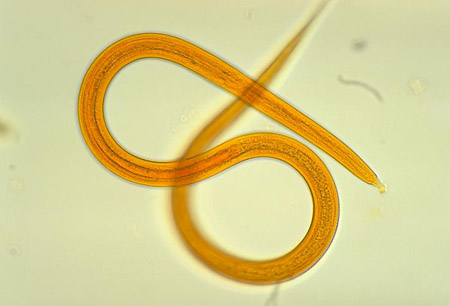Summary
Definition
History and exam
Other diagnostic factors
- abdominal pain
- altered bowel habit
- weight loss
- fever (hyperinfection)
- signs of sepsis (hyperinfection)
- chronic cough
- wheezing
- pruritus or dermatitis
- larva currens
- urticaria
- cutaneous larva migrans
- apparent drug reaction rash (hyperinfection)
- other skin complaints
- symptoms and signs of inflammatory bowel disease
Risk factors
- soil exposure in or migrants from an endemic area of the world
- international travellers
- corticosteroids (risk of hyperinfection)
- human T-cell lymphotropic virus type-1 (HTLV-1) infection (risk of hyperinfection)
- impaired immunity
- solid-organ transplant recipient
Diagnostic investigations
1st investigations to order
- stool ova and parasites (O&P) examination
- FBC with differential
- therapeutic trial with ivermectin (in specific situations)
Investigations to consider
- sputum O&P examination
- clinical sample (non-stool or sputum) O&P examination
- strongyloides IgG serology
- tissue biopsy
Treatment algorithm
Contributors
Authors
David R. Boulware, MD, MPH, CTropMed

Professor of Medicine
Department of Medicine
University of Minnesota
Minneapolis
MN
Disclosures
DRB is an author of a number of references cited in this topic.
Peer reviewers
Elizabeth Barnett, MD
Professor
Department of Pediatrics
Boston Medical Center
Boston University
Boston
MA
Disclosures
EB declares that she is on a speaker's bureau for Merck. She is an author of a reference cited in this topic.
Linda Nield, MD, FAAP
Professor of Pediatrics
West Virginia University School of Medicine
Morgantown
WV
Disclosures
LN is an author of a reference cited in this topic.
Geoff Gill, MA, MSc, MD, FRCP, DTMH
Professor of International Medicine and Honorary Consultant Physician
Liverpool School of Tropical Medicine
Liverpool
UK
Disclosures
GG declares that he has no competing interests.
Peer reviewer acknowledgements
BMJ Best Practice topics are updated on a rolling basis in line with developments in evidence and guidance. The peer reviewers listed here have reviewed the content at least once during the history of the topic.
Disclosures
Peer reviewer affiliations and disclosures pertain to the time of the review.
References
Key articles
World Gastroenterology Organisation. WGO practice guideline: management of strongyloidiasis. February 2018 [internet publication].Full text
Loutfy MR, Wilson M, Keystone JS, et al. Serology and eosinophil count in the diagnosis and management of strongyloidiasis in a non-endemic area. Am J Trop Med Hyg. 2002 Jun;66(6):749-52. Abstract
Henriquez-Camacho C, Gotuzzo E, Echevarria J, et al. Ivermectin versus albendazole or thiabendazole for Strongyloides stercoralis infection. Cochrane Database Syst Rev. 2016 Jan 18;(1):CD007745.Full text Abstract
Reference articles
A full list of sources referenced in this topic is available here.
Use of this content is subject to our disclaimer
